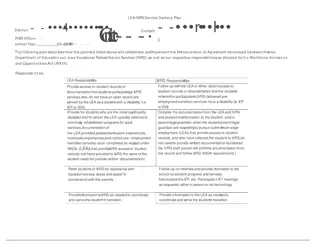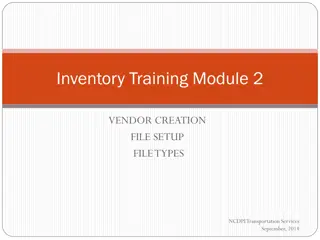
Understanding Length Extension Attacks on Hash Functions
Explore the concept of length extension attacks on hash functions, learn how they can be used to append data to signed messages, and gain practical experience in executing such attacks. Understand the vulnerabilities in Merkle-Damgård construction and how attackers can exploit them to include extra data without knowledge of the secret key.
Download Presentation

Please find below an Image/Link to download the presentation.
The content on the website is provided AS IS for your information and personal use only. It may not be sold, licensed, or shared on other websites without obtaining consent from the author. If you encounter any issues during the download, it is possible that the publisher has removed the file from their server.
You are allowed to download the files provided on this website for personal or commercial use, subject to the condition that they are used lawfully. All files are the property of their respective owners.
The content on the website is provided AS IS for your information and personal use only. It may not be sold, licensed, or shared on other websites without obtaining consent from the author.
E N D
Presentation Transcript
Workshop 2: Length Extension Attack Zhou Peng March 07, 2014
Objectives Understand one-way hash function and message digest. Understand how to use length extension attack to append data to a signed message Obtain hands-on experience for length extension attack 2
One-way Hash Function A function that is easy to compute on every input, but hard to invert given random inputs Let h() be a one-way function Assuming h(a)=b Given a, it is easy to compute b Given b, it is hard to compute a MD5, SHA-1, SHA-256 etc. Try SHA-1 calculator at http://www.xorbin.com/tools/sha1- hash-calculator References: http://en.wikipedia.org/wiki/Cryptographic_hash_function 3
Message Authentication Code (MAC) MAC is used to verify the data integrity of a message Using a one-way function to calculate a hash value of a secret concatenated by a given message Let m be a message and s be a secret. Let s||m be s concatenated by m Secret s is used for authentication Message digest h(s||m) is used by the receiver to verify whether message m is modified by attackers in transit. Why? References: http://en.wikipedia.org/wiki/Message_authentication_cod e 4
Length Extension Attacks A type of attack against hash functions which allow inclusion of extra data without the knowledge of secret Attack details Knowledge: h(s||m) and m, Target: Appends m to m, and computes correct h(s||m||m ) Exploit: A vulnerability in Merkle Damg rd construction, which literately calls hash functions on a message block basis. References: http://en.wikipedia.org/wiki/Length_extension_attack 5
MerkleDamgrd construction Merkle Damg rd construction breaks original data (s||m) into message blocks. Let b be the size of a message block. If (s||m)%b! = 0, an additional content p should be padded to s||m to ensure (s||m||p)%b == 0. References: http://en.wikipedia.org/wiki/Length_extension_attack 6
MerkleDamgrd construction Merkle Damg rd constructs a hash chain based on message blocks, where each hash value of predecessor is used as the input to the successor hash function References: http://en.wikipedia.org/wiki/Length_extension_attack 7
Vulnerability Attackers have the knowledge of h(s||m||p) and m. Attackers should guess the length of the secret s to compute p. Attackers thus can append arbitrary data to original data with its paddings (i.e., m||p) and can compute the correct hash of the appended message. Why? 8
Vulnerability The original data of h(s||m||p||m ||p ) is m||p||m , where m is the data controlled by attackers and p requires the attackers to guess. Guessing the length of secret s is the key to compute the padding content p!!! 9
Public Padding Pattern The padded data p follows a standard: The first bit of p is 1, then followed by many successive 0 bits until 64 bits left for the padding length of s||m. References: https://blog.skullsecurity.org/2012/everything-you- need-to-know-about-hash-length-extension-attacks 10
Padding Details Given a length of (s||m) 80 bits (10 bytes). Pad (512-80) = 432 bits in total First pad format-fixed (512-80 -64) = 368 bits. The 368 bits of padding is (10000000 .000), 1 1 and 367 0 The last 64 bits for padding the length of s||m Attackers should guess length of s||m. Length extension attack! References: https://blog.skullsecurity.org/2012/everything-you- need-to-know-about-hash-length-extension-attacks11
A Length Extension Attack Example Assuming the secret is password , the original data is data , then the SHA-1 signature is 6f5a7284246a7693c5f37f19f26609af84f56431 Attackers attempt to append attacking to the original data. The new data is (you see %60 as the length of (s||m) = 12bytes = 96 (0x60) bits) data%80%00%00%00%00%00%00%00%00%00%00%00%00%00%00%00%0 0%00%00%00%00%00%00%00%00%00%00%00%00%00%00%00%00%00% 00%00%00%00%00%00%00%00%00%00%00%00%00%00%00%00%00%60 attacking The new signature is a2feef179114b40605307e0ca260a3e72a56017c 12
Tool hash_extender: https://github.com/iagox86/hash_extender VM: Y:\Tutorials\VM_image\Ubuntu12\ubuntu_xp.cmd Command line usage: sudo apt-get install git g++ libssl-dev git clone https://github.com/iagox86/hash_extender cd hash_extender/ make ./hash_extender h ./hash_extender -d data -a attacking -l 8 -s 6f5a7284246a7693c5f37f19f26609af84f56431 -f sha1 --out- data-format=html 13
Demo Page http://158.132.255.16:25005/comp444/demo.php?d=data&h=6f5a7284246a7 693c5f37f19f26609af84f56431 Attacker knows the hash function is SHA-1() and the length of secret is 8. They try to append new data attacking to the end of the original data: http://158.132.255.16:25005/comp444/demo.php?d=dataattacking&h=6f5a7284246a7693c5 f37f19f26609af84f56431 See what happens? ./hash_extender -d data -a attacking -l 8 -s 6f5a7284246a7693c5f37f19f26609af84f56431 -f sha1 --out-data-format=html Type: sha1 Secret length: 8 New signature: a2feef179114b40605307e0ca260a3e72a56017c New string: data%80%00%00%00%00%00%00%00%00%00%00%00%00%00%00%00%00%00%00 %00%00%00%00%00%00%00%00%00%00%00%00%00%00%00%00%00%00%00%00 %00%00%00%00%00%00%00%00%00%00%00%00%60attacking http://158.132.255.16:25005/comp444/demo.php?d=data%80%00%00%00%00%00%00%00 %00%00%00%00%00%00%00%00%00%00%00%00%00%00%00%00%00%00%00%00%00%00 %00%00%00%00%00%00%00%00%00%00%00%00%00%00%00%00%00%00%00%00%00%60 attacking&h=a2feef179114b40605307e0ca260a3e72a56017c See what happens? 14
Preventing Length Extension Attack Possible Solutions MAC: h(s||m||s) HMAC: h(s opad ||h(s ipad ||m)) Try HMAC at http://www.freeformatter.com/hmac- generator.html Whether the length extension attack is defeated? Reference: http://en.wikipedia.org/wiki/Hash- based_message_authentication_code 15
Problems 1. Given a secret password , a SHA-1 hash 6d5f807e23db210bc254a28be2d6759a0f5f5d77 and an original data polyu , please append a new message computing to the end of original data, and let me know the result of appended data and the new digest. (10 marks) a. Please use out-data-format=html for your answer. 2. Given a vulnerable web page http://158.132.255.16:25005/comp444/assignment.php?d=data&h=46071a 0ad0dc4c51e83d05410ff80b80f3ee6cc1, please append a new message attacking to the end of parameter d and make web server accepts your data (you should see the message Your hash is correct. Great! in your browser). Answer the following questions: a. Hong long of the secret used by the vulnerable page? (5 marks) b. What is the new digest when you successfully append attacking ? (5 marks) 16
Problems (Cont.) 3. Given a block size of 512bits, is it possible that the size of padding content larger than 512 bits? If no, please elaborate your reason. If yes, please give examples. (10 marks) Hint: each padding must have 64-bits padding length and at least one bit. 4. Test whether other well-known hash functions (http://en.wikipedia.org/wiki/Cryptographic_ha sh_function, except for SHA-1 and MD5) suffer from the length extension attacks (1 mark each). Include the output of each successful attack. 17
Submission The questions will be submitted with other workshop questions at the end of the term. 18
Questions? 19


![[PDF READ ONLINE] Mountain Claiming (BIG-Secrets of Mountain Men Book 3)](/thumb/42287/pdf-read-online-mountain-claiming-big-secrets-of-mountain-men-book-3.jpg)



















